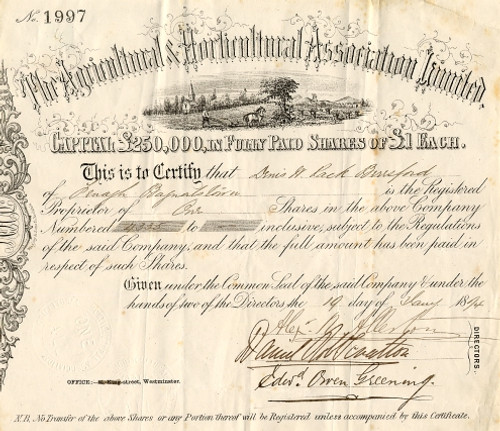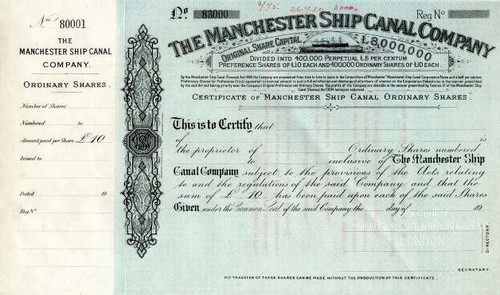Beautiful certificate from the Manchester Botanical and Horticultural Society issued in 1875. This historic document has an ornate border around it. This item has the signature of the Socirty's Treasurer, John Watts and is over 134 years old. Administrative/Biographical History The Royal Botanical and Horticultural Society of Manchester and the Northern Counties was founded in 1827 as the Manchester Botanical and Horticultural Society. The Manchester Mercury of 7 August 1827 records that a meeting was held at the (old) Manchester Town Hall in King Street on 30 July, chaired by Edward Loyd, to consider the formation of such a Society. Resolutions were approved to form the Society, to purchase land for a botanical and horticultural garden for Manchester and the neighbourhood, to erect proper greenhouses, and to finance these activities through deposits and subscriptions of life and hereditary members. A Council of Management was established under the chairmanship of Mr Loyd, and immediately eighty-six hereditary members were enrolled (MBH7/2/1). The purpose of the Manchester Botanical and Horticultural Society was a serious one: not only to lay out gardens for the recreation of the citizens of Manchester (who would otherwise be deprived of such pleasures in the industrial city) but also to further the scientific disciplines of botany and horticulture. For it was claimed that "The study of botany has not been pursued in any part of the country with greater assiduity and success than in the neighbourhood of Manchester" (MBH7/3/1). Self-improvement and the pursuit of scientific knowledge flourishing in the burgeoning city. A further, social and political, motive for the foundation of the Society was identified by the Mirror of Literature, Amusement and Instruction in 1833: "What can be a more delightful relaxation to a Lancashire Mechanic than an hour or two in a Garden: what an escape from the pestiferous politics of the times" (MBH7/3/1). It must be remembered that the Peterloo Massacre had taken place a mere eight years earlier. The Manchester scientist John Dalton was consulted as to the most salubrious site for a garden close to Manchester. He recommended Old Trafford, south-west of the city (the prevailing wind carried the city's airborne pollution eastward). In February 1829 sixteen acres of land in Old Trafford were conveyed by Thomas Joseph Trafford to John Holt Stanway of Manchester, for use as a botanical garden. Stanway leased the property to the trustees of the Society for 2000 years (MBH1/1-5). By 1839 the gardens had matured, with fine specimens of trees and shrubs in the extensive arboretum. In the summer season exhibitions of fruits, flowers and plants proved very popular. The magnificent plant houses and conservatories extended some 321 feet in length and the domed roof of the central conservatory was forty feet high. Within were rare and beautiful specimens of plants collected from around the world. Elsewhere in the gardens were an ornamental lake, rockery, rosarium, extensive lawns, and a fruit garden with forcing houses. In 1839 there were 440 hereditary members enrolled (MBH7/3/2). During the 19th century the financial fortunes of the Society fluctuated, as it struggled to repay debt and to finance the upkeep and improvement of the Old Trafford Gardens. In 1857 the Gardens hosted the United Kingdom Art Treasures' Exhibition, which was opened by Prince Albert. The exhibition was staged in a vast glass-and-iron hall, resembling Paxton's Great Exhibition structure, and attracted in excess of 1.3 million visitors over a period of 142 days (MBH7/3/15). The question of opening the Gardens on Sundays aroused strong feelings among proponents and objectors, but was eventually approved in 1870. In 1876 the Society was granted Royal patronage by Queen Victoria, and changed its name to the Royal Manchester Botanical and Horticultural Society. In 1882 it was proposed that a 'rather more ambitious name should be adopted', and ever since the Society has been styled the Royal Botanical and Horticultural Society of Manchester and the Northern Counties. Royal patronage has been renewed on the accession of successive monarchs. However, in 1997 the Society was informed that Royal patronage would be withdrawn in 2002, although the Society could retain the word 'Royal' in its name and the use of the Royal coat of arms on documents. The Earls of Derby have had a long association with the Society; since 1879 successive Earls have held the Presidency of the Society (MBH7/2). The fortunes of the Old Trafford Gardens reached their zenith in the 1880s. In 1887 an Exhibition of Art, Science and Industry was held to commemorate Queen Victoria's Golden Jubilee. The site was extended from the Botanical Gardens across Talbot Road, to the Manchester South Junction and Altrincham Railway. The main building, designed by Maxwell & Tuke, was cross-shaped, measuring 1000 feet in length, with a central dome 140 feet high. The exhibition lasted 192 days and some 4.75 million people attended. It was reported in 1889 that prior to the Exhibition attendance at the Gardens had been "somewhat exclusive", but the Exhibition encouraged greater use by the general public (MBH7/3/21). Paradoxically, there was a simultaneous decline in membership of the Society, and subscription income fell. Wealthy Mancunians had moved out of the city to the suburbs and to outlying villages such as Didsbury, Bowdon and Alderley Edge, where they could indulge their horticultural interests in their own extensive gardens. By the end of the 19th century interest in the Old Trafford Gardens had declined steeply. After attempts to persuade Stretford District Council and Manchester City Council to purchase the Gardens had proved unsuccessful, in 1907 the site was leased to the White City Limited, part of which was to used as an amusement park (MBH1/22, MBH7/3/9). A special general meeting held on 1 November 1927 resolved to sell the remainder of the land belonging to the Society, amounting to eleven acres, to Canine Sports Ltd, for use as a greyhound stadium (MBH2/1/6). The sum paid was D40,000, less expenses. In 1934 it was stated that the Society's "main purpose and object shall be the promotion of science and art in botany and horticulture"(MBH2/1/7). During the 20th century the Society has undertaken two principal activities: the running of flower shows, and the support of other organizations associated with botany and horticulture. For many years the Society ran flower shows at Manchester Town Hall. After 1972 the running of these shows was taken over by the North West Counties Chrysanthemum Society and League, which currently holds three-day shows each September and November at the Arndale Centre, Stretford (MBH7/4, information from Mr Goulty). Many societies, charities and educational institutions concerned with botany and horticulture have benefited from financial support by the Royal Botanical and Horticultural Society of Manchester and the Northern Counties. Grants have been provided to assist with the establishment and enhancement of gardens, the provision of facilities for disabled and underprivileged gardeners, the staging of horticultural shows, and the support of teaching and research in botany and horticulture. In 1935 the Society bestowed upon the University of Manchester D69,000 3% Local Loans Stock for the promotion of research and instruction in horticulture. Part of this benefaction was used to purchase land at Jodrell Bank in Cheshire for use by the Botany Department (MBH7/1/5, MBH7/1/33). After the Second World War the Mark 1A Radio Telescope was constructed on the site by Sir Bernard Lovell. The history of the Royal Botanical and Horticultural Society of Manchester and the Northern Counties was perhaps best summarized by its Chairman, Mr A.E.R. Goulty, in his review of its 150th Anniversary in 1977: 'Perhaps one may reach the wry conclusion that the Royal Botanical Society has been more successful in its recent years of gardening by proxy, than in the past generations of struggle at Old Trafford' (MBH7/1/33). History from University of Manchester, John Rylands University Library of Manchester.
Manchester Botanical and Horticultural Society - England 1875
MSRP:
$295.00
$250.00
(You save
$45.00
)
- SKU:
- newitem151093344
- Gift wrapping:
- Options available in Checkout










